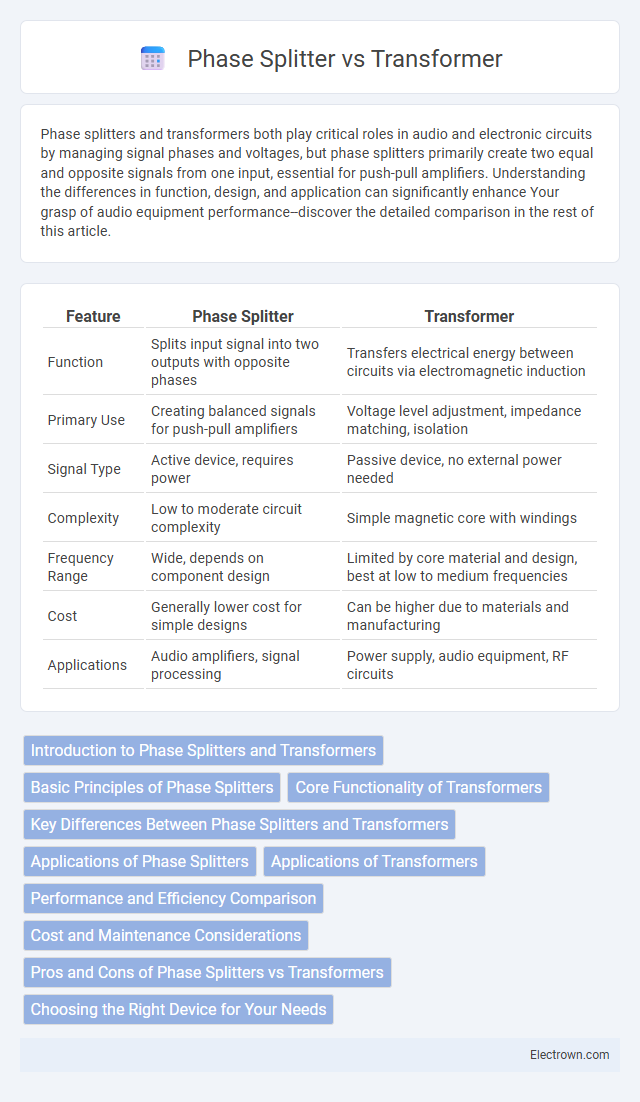Phase splitters and transformers both play critical roles in audio and electronic circuits by managing signal phases and voltages, but phase splitters primarily create two equal and opposite signals from one input, essential for push-pull amplifiers. Understanding the differences in function, design, and application can significantly enhance Your grasp of audio equipment performance--discover the detailed comparison in the rest of this article.
Table of Comparison
| Feature | Phase Splitter | Transformer |
|---|---|---|
| Function | Splits input signal into two outputs with opposite phases | Transfers electrical energy between circuits via electromagnetic induction |
| Primary Use | Creating balanced signals for push-pull amplifiers | Voltage level adjustment, impedance matching, isolation |
| Signal Type | Active device, requires power | Passive device, no external power needed |
| Complexity | Low to moderate circuit complexity | Simple magnetic core with windings |
| Frequency Range | Wide, depends on component design | Limited by core material and design, best at low to medium frequencies |
| Cost | Generally lower cost for simple designs | Can be higher due to materials and manufacturing |
| Applications | Audio amplifiers, signal processing | Power supply, audio equipment, RF circuits |
Introduction to Phase Splitters and Transformers
Phase splitters and transformers serve different purposes in electrical circuits; phase splitters convert a single input signal into two output signals with opposite phases, commonly used in audio amplification to drive push-pull stages. Transformers transfer electrical energy between two or more circuits via electromagnetic induction, providing voltage transformation, impedance matching, and isolation. Choosing between a phase splitter and a transformer depends on your specific application requirements, such as phase inversion, signal integrity, and power handling.
Basic Principles of Phase Splitters
Phase splitters operate by converting a single input signal into two output signals that are equal in amplitude but opposite in phase, essential for push-pull amplifier designs. Unlike transformers, which rely on electromagnetic induction and magnetic cores to achieve phase splitting and impedance matching, phase splitters use active or passive electronic components like transistors or resistors to create the phase-inverted signals. Understanding these basic principles helps you select the right approach for optimizing signal integrity and amplifier efficiency in your audio or RF applications.
Core Functionality of Transformers
Transformers in audio systems serve as impedance matching devices and electrical isolation elements, enabling efficient signal transfer between circuits while minimizing noise and distortion. Their core functionality includes voltage step-up or step-down and maintaining signal integrity across varying loads. Unlike phase splitters that generate two signals with opposite phases, transformers primarily focus on enhancing signal strength and stability within audio equipment.
Key Differences Between Phase Splitters and Transformers
Phase splitters convert a single input signal into two outputs with equal amplitude but opposite phase, essential for driving push-pull amplifier stages. Transformers transfer electrical energy between circuits through magnetic induction while providing isolation and impedance matching; they do not inherently create phase inversion unless specifically designed as phase-splitting transformers. Understanding these key differences helps you choose the right component for audio amplification or signal processing applications.
Applications of Phase Splitters
Phase splitters are widely used in audio amplification systems to create balanced signals for push-pull amplifier circuits, enhancing sound quality by minimizing distortion and noise. They are essential in wireless communication equipment for generating out-of-phase signals required in modulation techniques. Phase splitters also find application in instrumentation and signal processing where accurate phase relationships between signals are critical for system performance.
Applications of Transformers
Transformers are widely used in audio applications such as impedance matching, isolation, and signal balancing in professional sound systems and recording studios. They enable efficient voltage step-up or step-down in power supplies, ensuring stable power delivery in electronic devices. Additionally, audio transformers improve signal integrity by minimizing noise and distortion in communication systems.
Performance and Efficiency Comparison
Phase splitters offer precise signal symmetry and low distortion, enhancing audio performance in high-fidelity circuits, while transformers provide robust isolation and impedance matching but may introduce core saturation and frequency response limitations. Efficiency in phase splitters tends to be higher due to lower power loss and lighter components, whereas transformers can be bulkier and less efficient due to winding resistance and core losses. Your choice should balance the need for signal purity and power efficiency depending on application requirements.
Cost and Maintenance Considerations
Phase splitters generally offer a more cost-effective solution with lower initial investment and reduced maintenance requirements compared to transformers, which often entail higher purchase prices and periodic servicing due to their complex magnetic components. Transformers demand regular inspection for insulation integrity and potential core issues, contributing to increased maintenance costs over time. Phase splitters, using simpler circuitry, typically experience fewer failures, leading to decreased downtime and overall expenses.
Pros and Cons of Phase Splitters vs Transformers
Phase splitters offer precise control of audio signal phase with minimal distortion, making them ideal for balanced output stages, but they can be complex and require additional circuitry. Transformers provide galvanic isolation and impedance matching, enhancing signal integrity and noise rejection, yet they may introduce phase shifts and have limited bandwidth compared to active splitters. Choosing between the two depends on the specific application, with transformers favored for simplicity and isolation, while phase splitters excel in accuracy and linearity.
Choosing the Right Device for Your Needs
Selecting between a phase splitter and a transformer depends on application requirements such as signal integrity, power handling, and frequency response. Phase splitters excel in audio circuit designs where precise phase inversion and low distortion are critical, while transformers offer superior isolation and impedance matching for power and signal transfer across diverse industrial uses. Evaluating factors like load impedance, frequency range, and electrical isolation will guide the best device choice for optimal performance in audio amplification or power conversion systems.
Phase splitter vs Transformer Infographic

 electrown.com
electrown.com